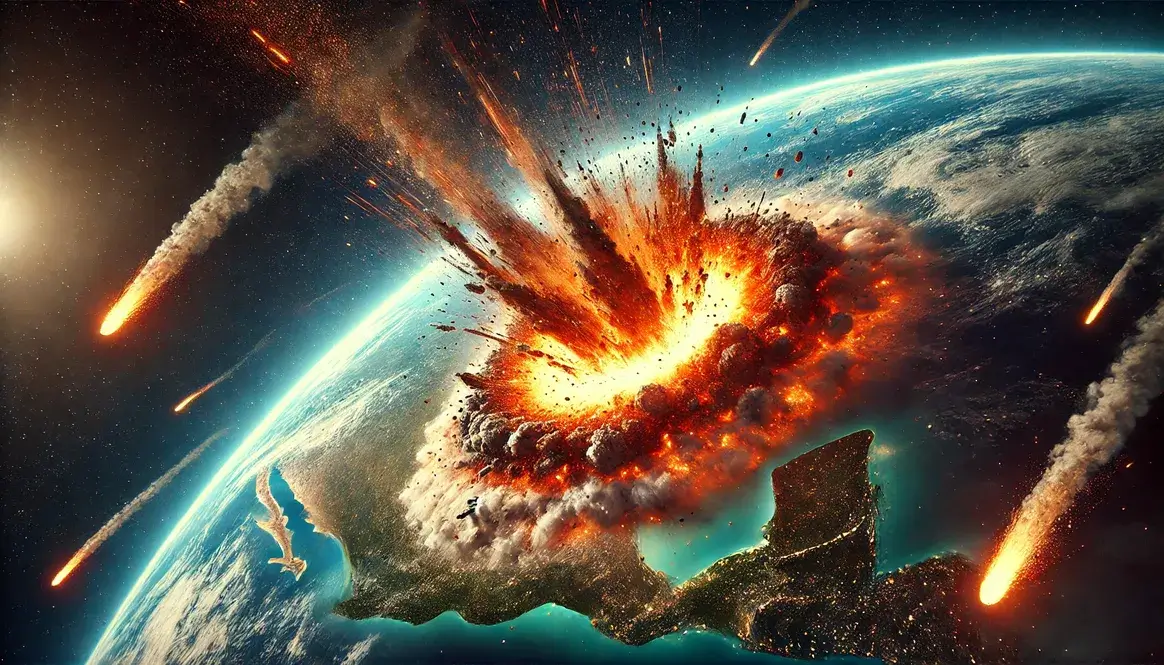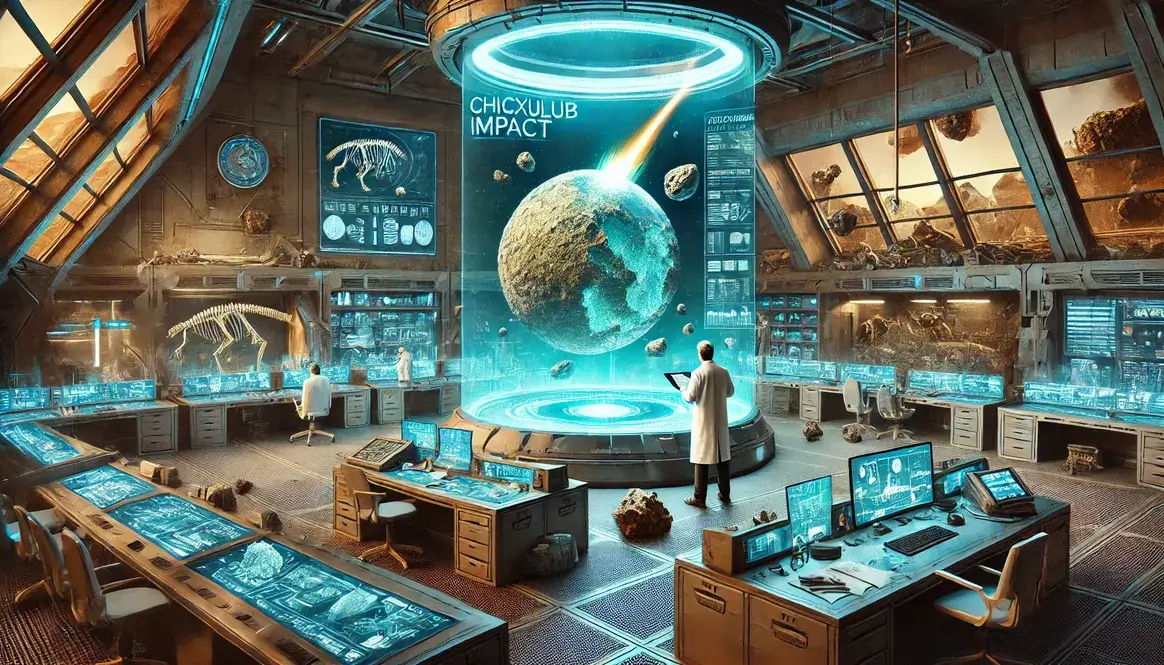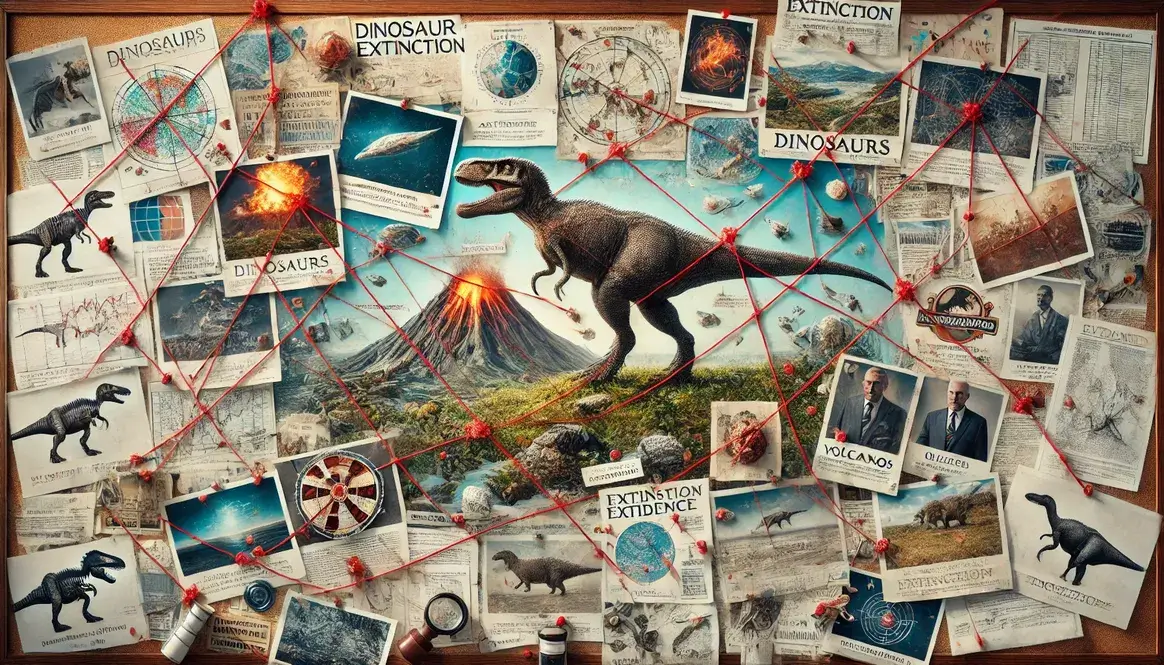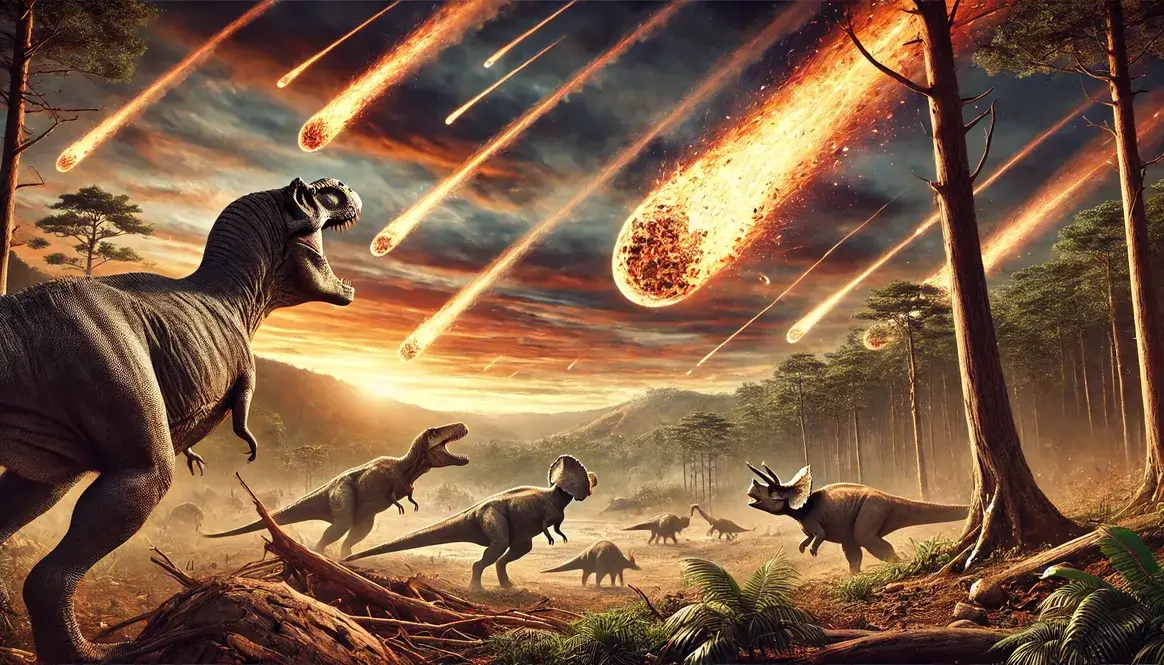Our planet has a long history of getting hit by space rocks. Some of these impacts were so big they changed the course of life on Earth! Let’s explore the biggest asteroid impacts on Earth that have left their mark on our world.
| Impact Event | Age (Million Years) | Crater Diameter (km) | Estimated Impactor Size (km) |
|---|---|---|---|
| Vredefort | 2,023 | 300 | 10-15 |
| Sudbury | 1,849 | 250 | 10-15 |
| Chicxulub | 66 | 150 | 10-15 |
| Popigai | 35.7 | 100 | 5-8 |
| Manicouagan | 214 | 100 | 5 |
Earth’s cosmic collision history
Earth has been a cosmic punching bag for billions of years. Since its formation about 4.5 billion years ago, our planet has been hit by countless asteroids and comets. These impacts have shaped Earth’s surface, affected its climate, and even influenced the evolution of life.
In the early days of Earth, impacts were much more common. This period, called the Late Heavy Bombardment, ended about 3.8 billion years ago. But big impacts didn’t stop there. Throughout Earth’s history, large asteroids have continued to strike, leaving behind massive craters and causing significant changes to our planet.
Top 5 biggest asteroid impacts on Earth
While thousands of impacts have occurred over Earth’s lifetime, some stand out as true giants. These massive collisions left craters hundreds of kilometers wide and had far-reaching effects on our planet. Let’s count down the top five biggest asteroid impacts on Earth we know about.
The Vredefort impact
The Vredefort impact takes the crown as the largest known asteroid impact on Earth. Here’s what we know about this cosmic collision:
- When and where: This enormous impact happened about 2 billion years ago in what is now South Africa.
- Size: The asteroid that caused this impact was likely between 10 to 15 kilometers wide – that’s about the size of a small city! The crater it left behind was massive, estimated to be 300 kilometers in diameter.
- Effects: The Vredefort impact was so powerful that it literally shook the planet. It would have caused worldwide earthquakes, massive tsunamis, and thrown up enough dust and debris to block out the sun for months or even years. This impact may have had significant effects on the evolution of life on Earth, although its exact consequences are still being studied.
Today, much of the original crater has eroded away, but we can still see its remnants in the Vredefort Dome, a UNESCO World Heritage site. It’s a reminder of the enormous forces that have shaped our planet throughout its history.
The Sudbury impact
The Sudbury impact is another heavyweight in Earth’s collision history. This ancient impact occurred about 1.85 billion years ago in what is now Ontario, Canada.
The asteroid that caused this impact was a true giant, estimated to be between 10 to 15 kilometers wide. When it slammed into Earth, it created a massive crater about 250 kilometers in diameter. That’s larger than many countries!
The consequences of the Sudbury impact were far-reaching:
- Worldwide climate changes
- Possible mass extinctions
- Formation of valuable mineral deposits
Interestingly, the Sudbury impact site is now one of the world’s largest sources of nickel and copper. This cosmic collision quite literally shaped the economic landscape of the region!
The Chicxulub impact
Perhaps the most famous of all asteroid impacts, the Chicxulub event changed the course of life on Earth.
Time and place: This impact occurred about 66 million years ago, striking the Yucatan Peninsula in Mexico.
Size and characteristics: The Chicxulub asteroid was a monster, measuring about 10-15 kilometers across. It left behind a crater approximately 150 kilometers wide and 20 kilometers deep.
Link to dinosaur extinction: This impact is widely believed to have caused the extinction of the dinosaurs. The collision released an enormous amount of energy, equivalent to billions of atomic bombs. It triggered global climate changes, including:
- Worldwide wildfires
- Massive tsunamis
- Years of darkness due to dust and debris in the atmosphere
These dramatic changes led to the extinction of about 75% of plant and animal species on Earth, including most dinosaurs. However, this event also paved the way for the rise of mammals and eventually, humans!
The Popigai impact
The Popigai impact, while not as large as some others on our list, has some unique features that make it stand out.
This cosmic collision happened much more recently in Earth’s history, about 35.7 million years ago. The impact site is located in Siberia, Russia, and is named after the Popigai River that flows through the area.
The asteroid that caused this impact was smaller than our previous examples, estimated to be between 5 to 8 kilometers wide. However, it still packed a punch, creating a crater about 100 kilometers in diameter.
What makes the Popigai impact unique is the treasure trove it left behind. The impact transformed the graphite in the ground into diamonds! These aren’t just any diamonds, though. They’re incredibly hard and have special properties that make them valuable for industrial uses. Some scientists believe the Popigai crater might contain trillions of carats of these special diamonds.
The Popigai impact serves as a reminder that asteroid collisions can not only destroy but also create. While it undoubtedly caused significant local destruction, it also left behind a legacy that we’re still exploring today.
The Manicouagan impact
The Manicouagan impact rounds out our top five list of Earth’s biggest cosmic collisions. This event took place about 214 million years ago in what is now Quebec, Canada. The impactor, likely an asteroid about 5 kilometers wide, left behind a crater approximately 100 kilometers in diameter.
What makes the Manicouagan impact particularly interesting? Check out these cool facts:
- The impact created a unique ring-shaped lake that’s visible from space.
- It’s one of the best-preserved impact craters on Earth.
- The event might have played a role in the Triassic-Jurassic extinction, though this is still debated.
Today, the Manicouagan crater serves as a natural laboratory for scientists studying impact events and their effects on Earth’s geology and life.
Comparing the big hits
Let’s take a closer look at how these cosmic titans stack up against each other:
| Impact Event | Age (Million Years) | Crater Diameter (km) | Estimated Energy (Megatons TNT) | Major Effects |
|---|---|---|---|---|
| Vredefort | 2,023 | 300 | 1,000,000,000 | Global earthquakes, climate change |
| Sudbury | 1,849 | 250 | 500,000,000 | Mass extinctions, mineral deposits |
| Chicxulub | 66 | 150 | 100,000,000 | Dinosaur extinction, global winter |
| Popigai | 35.7 | 100 | 50,000,000 | Diamond formation |
| Manicouagan | 214 | 100 | 50,000,000 | Possible contribution to extinction event |
But how do scientists measure the size of these ancient impacts? It’s not as simple as taking a giant tape measure to a crater!
Researchers use a combination of methods to estimate impact size:
- Crater diameter: This is often the most visible evidence, but erosion can make it tricky to measure accurately.
- Rock deformation: The force of an impact leaves telltale signs in the surrounding rocks.
- Ejected material: The size and distribution of material thrown out by the impact can provide clues about its power.
- Chemical analysis: Certain chemical signatures in rocks can indicate an extraterrestrial origin.
By combining these methods, scientists can piece together a picture of these ancient cosmic collisions, helping us understand the powerful forces that have shaped our planet’s history.
Spotting ancient impacts
Finding evidence of ancient asteroid impacts is like being a cosmic detective. Scientists use various methods to identify these old collision sites, even when they’re not obvious to the naked eye.
Here are some key techniques used to spot impact craters:
- Satellite imagery: Looking at Earth from space can reveal circular patterns that might be impact craters.
- Geological surveys: On-the-ground investigations can uncover unusual rock formations.
- Geophysical methods: Techniques like gravity and magnetic surveys can detect hidden crater structures.
But what exactly are scientists looking for? The smoking guns of an impact event include:
- Shocked quartz: This mineral shows distinctive patterns under a microscope when it’s been hit by an enormous shock wave.
- Impact breccias: These are rocks made up of broken fragments cemented together during the impact.
- Tektites: Small, glass-like objects formed from rock that’s melted and cooled rapidly during an impact.
Finding these ancient impact sites isn’t always easy. Over millions of years, erosion and plate tectonics can erase or bury evidence. Some craters might be hidden under oceans or thick layers of sediment. That’s why new impact sites are still being discovered today, adding to our understanding of Earth’s cosmic collision history.
How often do big asteroids strike?
You might be wondering: should we be worried about another massive asteroid impact? Let’s break it down.
In Earth’s early days, large impacts were much more common. But as the solar system settled down, the frequency of big hits decreased. Today, truly massive impacts like the ones we’ve discussed are rare events.
Current estimates suggest:
- An asteroid 5-10 km wide (like the Chicxulub impactor) might strike Earth every 100 million years or so.
- Smaller but still significant impacts (1 km wide asteroids) might occur every 500,000 years.
These are just averages, though. The actual timing of impacts is random and unpredictable.
So how do scientists figure out these probabilities? They use a combination of methods:
- Studying the current population of near-Earth asteroids
- Analyzing the crater record on Earth and other planets
- Using computer models to simulate asteroid orbits and potential collisions
While the risk of a civilization-ending impact in our lifetime is very low, scientists around the world are working on ways to detect and potentially deflect dangerous asteroids. It’s a cosmic insurance policy for our planet!
Remember, small asteroids hit Earth all the time, but most burn up in our atmosphere before reaching the ground. Our atmosphere is like a protective shield, keeping us safe from the smaller space rocks whizzing around our solar system.
Cosmic shield: Earth’s atmosphere
Earth’s atmosphere isn’t just the air we breathe—it’s also our first line of defense against cosmic intruders. This invisible shield protects us from countless small asteroids and meteoroids that would otherwise bombard the surface.
How does it work? When a space rock enters Earth’s atmosphere at high speed, it experiences intense friction. This friction causes the object to heat up rapidly, often to temperatures higher than the surface of the Sun! Most smaller objects completely vaporize before they can reach the ground.
But how big does an asteroid need to be to survive this fiery journey? Here’s a quick breakdown:
| Asteroid Size | Typical Outcome |
|---|---|
| < 10 meters | Usually burns up completely |
| 10-50 meters | May explode in the atmosphere |
| > 50 meters | Likely to reach the surface |
While our atmosphere is great at protecting us from smaller objects, it can’t stop everything. Sometimes, larger asteroids make it through, creating spectacular events in the sky. Two famous examples are:
- The Tunguska Event (1908): An asteroid about 50-60 meters wide exploded over Siberia, flattening 80 million trees over 2,000 square kilometers. The blast was estimated to be as powerful as 1,000 Hiroshima bombs!
- The Chelyabinsk Meteor (2013): A 20-meter asteroid exploded over Russia, creating a shockwave that injured over 1,500 people and damaged thousands of buildings. This event was captured on many dashboard cameras, giving scientists valuable data on atmospheric impacts.
These events remind us that while Earth’s protective shield is effective against smaller objects, we still need to keep an eye on the sky for larger potential threats. That’s why scientists around the world are working on ways to detect and track near-Earth objects, helping to keep our planet safe from cosmic collisions.









